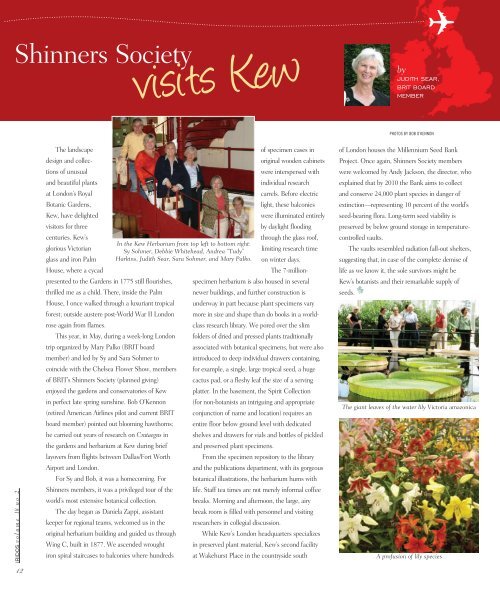Botanical Expedition! - Botanical Research Institute of Texas
Botanical Expedition! - Botanical Research Institute of Texas
Botanical Expedition! - Botanical Research Institute of Texas
You also want an ePaper? Increase the reach of your titles
YUMPU automatically turns print PDFs into web optimized ePapers that Google loves.
iridos volume 18 no 2<br />
Shinners Society<br />
12<br />
The landscape<br />
design and collec-<br />
visits Kew<br />
<strong>of</strong> specimen cases in<br />
original wooden cabinets<br />
tions <strong>of</strong> unusual<br />
were interspersed with<br />
and beautiful plants<br />
individual research<br />
at London’s Royal<br />
carrels. Before electric<br />
Botanic Gardens,<br />
light, these balconies<br />
Kew, have delighted<br />
were illuminated entirely<br />
visitors for three<br />
by daylight flooding<br />
centuries. Kew’s<br />
glorious Victorian<br />
In the Kew Herbarium from top left to bottom right:<br />
Sy Sohmer, Debbie Whitehead, Andrea “Tudy”<br />
through the glass ro<strong>of</strong>,<br />
limiting research time<br />
glass and iron Palm Harkins, Judith Sear, Sara Sohmer, and Mary Palko. on winter days.<br />
House, where a cycad<br />
The 7-million-<br />
presented to the Gardens in 1775 still flourishes, specimen herbarium is also housed in several<br />
thrilled me as a child. There, inside the Palm newer buildings, and further construction is<br />
House, I once walked through a luxuriant tropical underway in part because plant specimens vary<br />
forest; outside austere post-World War II London more in size and shape than do books in a world-<br />
rose again from flames.<br />
class research library. We pored over the slim<br />
This year, in May, during a week-long London folders <strong>of</strong> dried and pressed plants traditionally<br />
trip organized by Mary Palko (BRIT board<br />
associated with botanical specimens, but were also<br />
member) and led by Sy and Sara Sohmer to introduced to deep individual drawers containing,<br />
coincide with the Chelsea Flower Show, members for example, a single, large tropical seed, a huge<br />
<strong>of</strong> BRIT’s Shinners Society (planned giving)<br />
cactus pad, or a fleshy leaf the size <strong>of</strong> a serving<br />
enjoyed the gardens and conservatories <strong>of</strong> Kew platter. In the basement, the Spirit Collection<br />
in perfect late spring sunshine. Bob O’Kennon (for non-botanists an intriguing and appropriate<br />
(retired American Airlines pilot and current BRIT conjunction <strong>of</strong> name and location) requires an<br />
board member) pointed out blooming hawthorns; entire floor below ground level with dedicated<br />
he carried out years <strong>of</strong> research on Crataegus in shelves and drawers for vials and bottles <strong>of</strong> pickled<br />
the gardens and herbarium at Kew during brief and preserved plant specimens.<br />
layovers from flights between Dallas/Fort Worth From the specimen repository to the library<br />
Airport and London.<br />
and the publications department, with its gorgeous<br />
For Sy and Bob, it was a homecoming. For botanical illustrations, the herbarium hums with<br />
Shinners members, it was a privileged tour <strong>of</strong> the life. Staff tea times are not merely informal c<strong>of</strong>fee<br />
world’s most extensive botanical collection.<br />
breaks. Morning and afternoon, the large, airy<br />
The day began as Daniela Zappi, assistant break room is filled with personnel and visiting<br />
keeper for regional teams, welcomed us in the researchers in collegial discussion.<br />
original herbarium building and guided us through While Kew’s London headquarters specializes<br />
Wing C, built in 1877. We ascended wrought in preserved plant material, Kew’s second facility<br />
iron spiral staircases to balconies where hundreds at Wakehurst Place in the countryside south<br />
by<br />
Judith sear,<br />
Brit Board<br />
memBer<br />
PHOTOS By BOB O’KENNON<br />
<strong>of</strong> London houses the Millennium Seed Bank<br />
Project. Once again, Shinners Society members<br />
were welcomed by Andy Jackson, the director, who<br />
explained that by 2010 the Bank aims to collect<br />
and conserve 24,000 plant species in danger <strong>of</strong><br />
extinction—representing 10 percent <strong>of</strong> the world’s<br />
seed-bearing flora. Long-term seed viability is<br />
preserved by below ground storage in temperaturecontrolled<br />
vaults.<br />
The vaults resembled radiation fall-out shelters,<br />
suggesting that, in case <strong>of</strong> the complete demise <strong>of</strong><br />
life as we know it, the sole survivors might be<br />
Kew’s botanists and their remarkable supply <strong>of</strong><br />
seeds.<br />
The giant leaves <strong>of</strong> the water lily Victoria amazonica<br />
A pr<strong>of</strong>usion <strong>of</strong> lily species

















